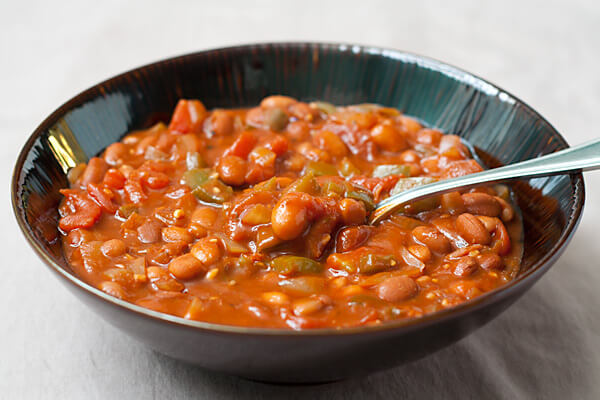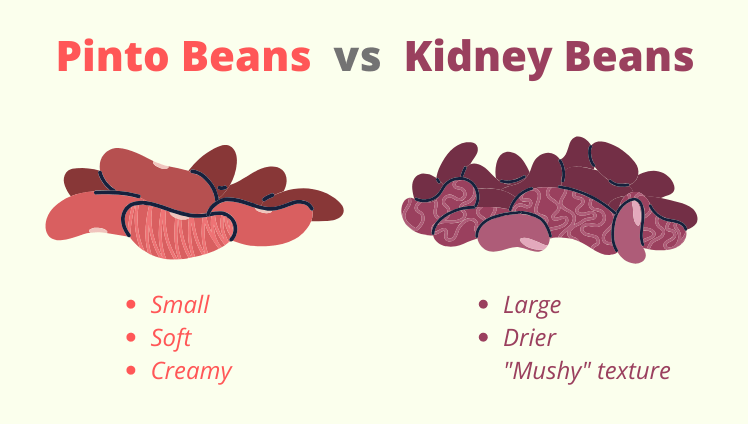Pinto beans and kidney beans are both easy to find in can or dry form.
But I’ve often wondered which one is best in terms of taste or nutrition (protein, calories, fiber, etc.), so I decided to find the answers and make a clear summary here.
As it turns out, there’s not a huge difference between them, but there are some small ones that may affect the one you choose to eat sometimes.
Table of Contents
Taste Test: Kidney Beans vs Pinto Beans
Compared to other types of beans, kidney beans and pinto beans are both soft and relatively plain.
They both absorb flavors well, which makes them great in recipes with lots of spices and flavors.
However, in my experience, pinto beans are a bit creamier, while I think of kidney beans as more on the dry side.
Kidney beans are larger and heartier, which is why they’re often the main bean used in chili.
Which Bean is Best in Chili?
As mentioned, kidney beans are the standard, but you can certainly swap in pinto beans if needed.
There aren’t too many chili recipes that call for pinto beans, but there are some.

Personally, I often throw just about every type of bean I can find into my chili, including both pinto and kidney beans.
Pinto beans and kidney beans have relatively similar texture and taste compared to other types of beans. They can be substituted for each other without too much issue if needed.
Side-By-Side Nutrition Comparison
The second main part of this comparison is to look at the nutritional value of both beans.
I’ve divided this into 2 sections.
First, we’ll look at the macro nutrients of both (that’s the calories, protein, etc.).
Then, we’ll look at the nutrients (vitamins and minerals).
Macro Nutritional Profile of Kidney and Pinto Beans
Like most common beans, the overall nutritional profile is quite similar for each of these:
| Kidney Beans | Pinto Beans | |
|---|---|---|
| Serving size | 1 cup | 1 cup |
| Calories | 225 | 245 |
| Fat | 0.9 g | 1.1 g |
| Carbohydrates | 40.4 g | 44.8 g |
| Fiber | 11.3 g | 15.4 g |
| Protein | 15.3 g | 15.4 g |
Pinto beans do have more calories, which could be slightly important if you’re on a cut.
Note that pinto beans also have quite a bit more fiber. But then again, if you’re having beans at all, you’re probably not lacking fiber in your diet.
While their macro nutritional profiles are similar, pinto beans do have slightly more calories, fiber, and fat than kidney beans.
Comparing the Nutrients in Kidney and Pinto Beans
Both beans have a few vitamins in them in significant amounts, and a ton of minerals.
Let’s look at how much of each nutrient each type of bean has, in terms of recommended daily value (%DV).
| Kidney Beans (%DV) | Pinto Beans (%DV) | |
|---|---|---|
| Serving size | 1 cup | 1 cup |
| Vitamin K | 19% | 7% |
| Thiamin | 19% | 22% |
| Vitamin B6 | 11% | 20% |
| Folate | 58% | 74% |
| Calcium | 6% | 8% |
| Iron | 22% | 20% |
| Magnesium | 19% | 21% |
| Phosphorus | 24% | 25% |
| Potassium | 20% | 21% |
| Zinc | 12% | 11% |
| Copper | 19% | 19% |
| Manganese | 38% | 39% |
Pinto beans “win” most categories, but most of those are by insignificant amounts.
The only big differences are that kidney beans have a lot more vitamin K, which isn’t a particularly important or hard to get vitamin, and that pinto beans have a decent amount more of folate (although both are great vegan sources of folate).
Overall, they’re quite similar.
There’s not a significant difference between the vitamin and mineral profile of kidney or pinto beans.
The Main Differences Between Pinto and Kidney Beans
Nutritionally speaking, they’re almost identical.
You should prefer kidney beans by a bit if you’re trying to lose weight, otherwise there aren’t any important differences.
The biggest difference is taste and texture. So honestly, just pick the one you like the taste of most, especially since they can be used in place of each other in most recipes without a huge change in meal quality.
While they’re all similar, you might also find my kidney bean vs black bean or pinto beans vs black beans posts interesting.

